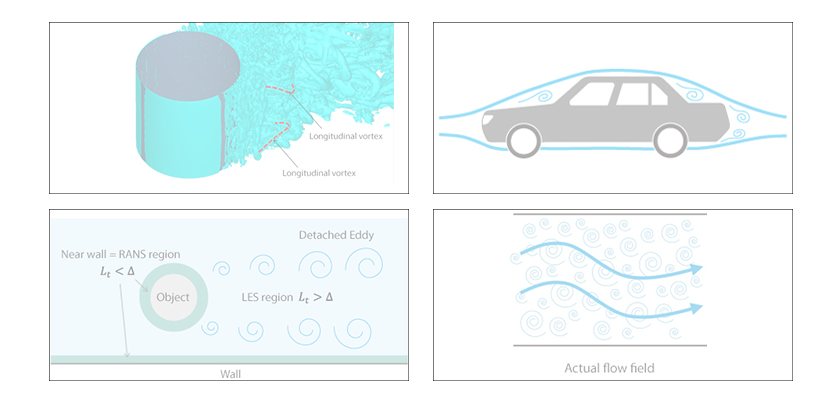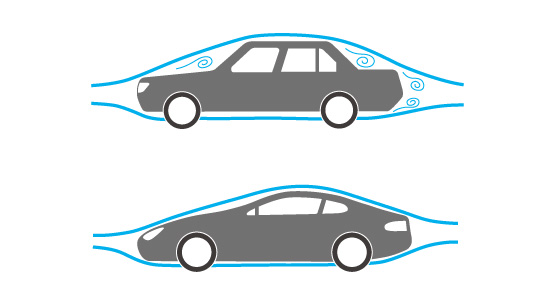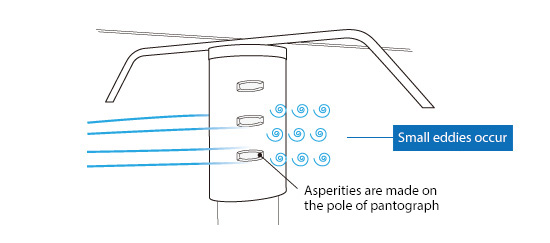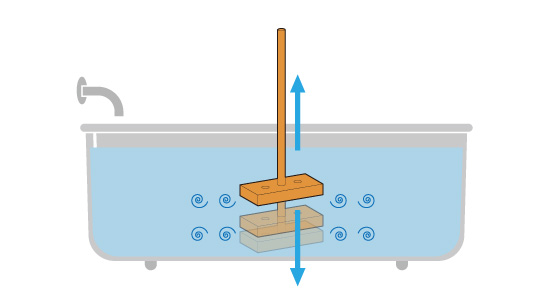Basic Course on Turbulence and Turbulent Flow Modeling 2: 2.1 Is a turbulent flow a nuisance? 2.2 Benefits of turbulent flows

What is a turbulent flow? (2)
– Advantages and disadvantages of a turbulent flow
2.1 Is a turbulent flow a nuisance?
Turbulent flow is all around us. It can be beneficial in some cases and not in others. When the airflow around a vehicle becomes turbulent, air resistance increases. Automobile companies, therefore, try to suppress turbulence and design an automobile body with lower air resistance to create a more fuel-efficient vehicle.

Figure 2.1: Air resistance around automobile
When the flow of a liquid transported in a tube such as a water pipe is turbulent, more force (energy) is required to transport the liquid. The shape of the tube can be designed so the energy necessary for the transportation is efficiently minimized.
A turbulent flow not only causes an increased flow resistance but also noise. For example, the movement of a high speed bullet train creates noise. Most of the noise is aerodynamically induced sound. The sound is generated when the air around the running bullet train becomes turbulent. The noise is objectionable because the train velocity is so high, and this is a great obstacle that prevents the bullet train from going faster. To solve this problem, the train body is made as smooth as possible, for example the gaps between the train bodies are minimized. The noise from an air conditioner or a fan is caused by turbulent flow. To decrease noise, the cross section of the air conditioner louvers and the shape of the fan blades are designed to suppress turbulent flow as much as possible. These are examples of problems caused by turbulent flow.
As previously mentioned, noise is caused by a turbulent flow. In some cases, the noise can be intentionally generated or altered to change the frequency of a sound. A well-known example is the serrations on the leading edge of an owl's wings that enable the owl’s flight to be virtually silent. The small serrations on the edge of the owl's wings generate small scale (quieter) turbulence to avoid the generation of large scale (noisy) turbulence. This approach can also be applied to a pantograph on a bullet train. Asperities (surface roughness) created on the surface of the poles of the pantograph generate small scale turbulence that reduce noise levels (Figure 2.2).

Figure 2.2: Pantograph
2.2 Benefits of turbulent flows
What are some benefits of turbulent flows? One of the benefits is that turbulent flow mixes the fluid very well. When hot water in a bath tub is vigorously stirred, the temperature of the hot water is more quickly lowered. The mixing action of the turbulent flow enhances the temperature averaging effect in addition to the transfer of energy from the hot water to the surrounding fluid. When a hot object is cooled, the mixing action of turbulent flows in the fluid surrounding the object plays an important role in cooling it (Figure 2.3).

Figure 2.3: Hot water in a bath tub
The following figures show analysis results for mixing hot water in a bath tab. Figure 2.4 is the temperature distribution. The hot water is mixed by up and down movement of a stick with a flat plate attached to it. In Figure 2.5, the white area represents turbulent flows. Turbulence occurs around the stick.
Figure 2.4: Mixing of hot water in a bath tab
Figure 2.5: Turbulence around a stick with a flat plate
Another example where turbulence is beneficial is when we blow on food to cool it down. The turbulence in the air (or any fluid) flow around an object enhances mixing between a hot fluid and a cooler fluid, even though the turbulence can't be seen with the naked eyes. When a wet object is dried by the wind, turbulence is also at work. A turbulent flow generated by the wind enhances mixing between the wet air and dry air. Some people shake their hair with their fingers when they dry it. Shaking the hair generates turbulence in the air, which helps make the hair dry faster.
The next article discusses turbulent flow and its role in the weather forecast.

About the Author
Takao Itami | Born in July 1973, Kanagawa, Japan
The author had conducted researches on numerical analyses of turbulence in college. After working as a design engineer for a railway rolling stock manufacturer, he took the doctor of engineering degree from Tokyo Institute of Technology (Graduate School of Science and Engineering) through researching compressible turbulent flow and Large-Eddy Simulation. He works as a consulting engineer at Software Cradle solving various customer problems with his extensive experience.


